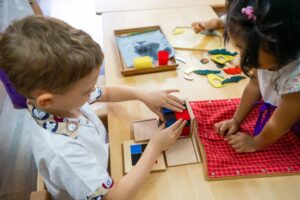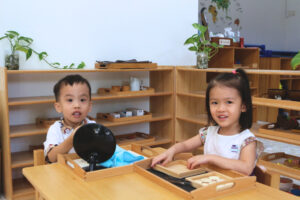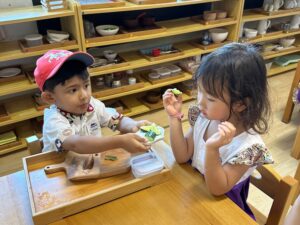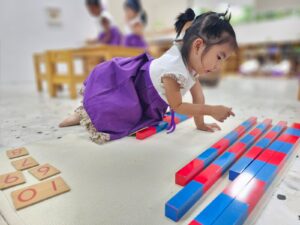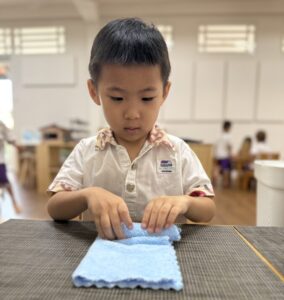At House on the Hill, our Nursery and Kindergarten children have been embarking on an exciting Sky Explorers journey as part of their thematic topic — discovering clouds, the water cycle, and how weather works.
Why Learning About Clouds, the Water Cycle, and Weather is Important?
At House on the Hill, learning is about fostering a child’s natural curiosity and helping them understand the world around them through hands-on exploration and meaningful experiences. Studying clouds, the water cycle, and weather fits perfectly into this approach because:
- Connection to Nature: Children develop a deep appreciation and respect for the natural world by observing and learning about everyday phenomena like clouds and rain. This nurtures their sense of wonder and responsibility for the environment.
- Sensory and Scientific Exploration: Weather is a dynamic, sensory-rich topic — children can see clouds, feel the wind, hear rain, and observe changes over time. This sensory engagement supports cognitive development and scientific thinking.
- Encourages Observation and Critical Thinking: Watching clouds and tracking weather patterns invites children to practice careful observation, recognise patterns, and make predictions, building foundational skills in scientific inquiry.
- Supports Language and Concept Development: Learning the names of different cloud types, understanding the water cycle, and describing weather encourages vocabulary growth and conceptual understanding.
- Promotes Curiosity: Montessori believes children are natural learners. By igniting the child’s innate sense of wonder through such weather-related activities, we empower the children to follow their interests.
By integrating these topics into our Montessori curriculum, children build a meaningful connection with their environment while developing key skills that form the foundation for lifelong learning.
6 Weather-Themed Activities
To support and extend this learning journey, here are six weather-themed Montessori-style activities you can enjoy at home with your child. Each activity encourages creativity, independence, and exploration using simple materials.
1. Cloud Spotting Adventures
Take a walk with your child and look up at the sky. Encourage them to use their imagination to describe what they see — maybe a dragon, a boat, or even a smiling face. This sparks creativity and observational skills. You can reference “The Cloud Song” we’ve been singing in class to make it more engaging.
- Materials: None needed, just a safe outdoor space or window view.
- Activity Details: Bring along a small notebook or sketchpad for your child to draw or jot down what shapes or animals they imagine in the clouds.
💡 Parent Tip: Let your child take the lead in spotting shapes. Avoid correcting what they “should” see — the goal is to encourage imaginative thinking, not accuracy.
2. DIY Weather Chart
Create a simple weather chart together. Each morning, have your child observe the sky and record the weather using symbols (e.g., ☀️, ☁️, 🌧). This builds scientific observation skills and an understanding of patterns.
- Materials: Large sheet of paper or poster board, markers or crayons, stickers (optional).
- Activity Details: Draw a grid with days of the week and space to draw or stick weather symbols. You can prepare simple weather symbol cards for your child to place on the chart or draw their own.
💡 Parent Tip: Keep the chart in a place your child can easily access, like their playroom or near the breakfast table, so it becomes a fun daily habit.
3. Water Cycle in a Bag
Recreate the water cycle with a zip-lock bag, water, and a sunny window. Draw clouds, raindrops, and the sun on the bag with a marker. Over time, your child can watch evaporation, condensation, and precipitation in action.
- Materials: Clear zip-lock plastic bag, water, permanent marker, tape.
- Activity Details: Fill the bag with a small amount of water (about 1/4 cup). Draw clouds, sun, raindrops on the outside of the bag. Tape the bag to a sunny window and observe changes over several days.
💡 Parent Tip: Take a few minutes each day to ask, “What’s changed in our bag?” This helps your child practise observation and recall skills.
4. Cloud Craft Creations
Make cloud art using cotton balls, paper, and glue. Label different types — cumulus (fluffy), stratus (flat), cirrus (wispy) — to connect craft time to scientific vocabulary.
- Materials: Cotton balls, white paper or cardstock, glue stick or liquid glue, markers or labels.
- Activity Details: Show your child how to stretch or fluff cotton balls to mimic different cloud types, then glue them on paper. Use markers or pre-made labels to write the names of each cloud type, or describe them with simple adjectives.
💡 Parent Tip: If your child isn’t ready for the scientific names yet, just focus on describing the clouds with everyday words like “fluffy,” “long,” or “soft.”
5. Food Art Fun
Inspired by our “Cloud Celebration” at school, create weather scenes with bananas, blueberries, and pretzel sticks. This combines sensory play, creativity, and healthy eating.
- Materials: Bananas (sliced), blueberries, pretzel sticks, plate or tray.
- Activity Details: Encourage your child to arrange the banana slices as clouds, blueberries as raindrops or berries, and pretzel sticks as rain or lightning bolts on the plate. Talk about the weather while you create.
💡 Parent Tip: Let your child help with the safe, age-appropriate food prep — peeling bananas, placing blueberries — to build fine motor skills and independence.
6. Storytime Under the Sky
Spread a blanket outside and read weather-themed books or poems together. Encourage your child to draw their own sky story afterwards.
- Materials: Weather-themed books or poems (check your library), drawing paper, crayons or pencils, blanket.
- Activity Details: Choose books with vivid illustrations (like “Cloudy With a Chance of Meatballs” or weather poetry). After reading, invite your child to draw what they imagine about the sky or weather.
💡 Parent Tip: Choose books with big, bold illustrations so they can connect the pictures to what they see in the real sky.
Why This Matters in Montessori Learning
Self-directed exploration, sensory experiences, and hands-on activities help children make sense of the world. By connecting home activities with what they’re learning in class, you’re supporting curiosity, independence, and a love of learning — the heart of the Montessori approach.
By bringing Montessori-inspired activities into your home, you create opportunities for your child to explore, discover, and build a meaningful connection to the universe—all through play and curiosity-led learning.
These simple Montessori-style activities allow your child to learn through hands-on experiences, practice independence, and develop a love for both science and creative expression.
Let your child lead the journey. Their questions, observations, and unique ideas are the most powerful learning tools of all.
Want to learn more about how we support learning beyond the classroom? Book a tour or get in touch with us today!

